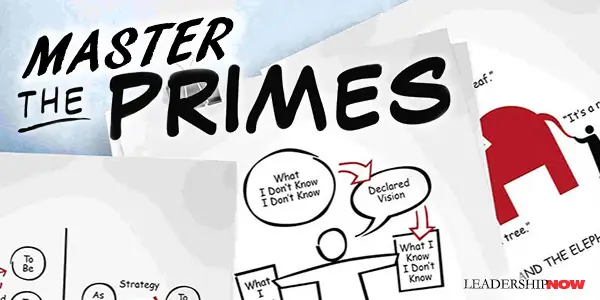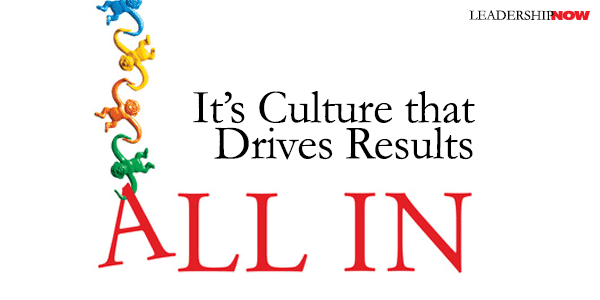 Leading Blog | Posts by Month |
 Leading Blog | Posts by Month |
04.30.12

LeadershipNow 140: April 2012 Compilation
Posted by Michael McKinney at 04:27 PM
04.25.12

When Good Employees Do Bad: Six Surprising Behaviors that May Precede a Scandal Good intentions can lead to bad outcomes in business. This is especially true in organizations that have toxic cultures in which leaders tout worthy values—and then put up roadblocks that prevent employees from living those values. For example, if a company claims it welcomes innovation and risk taking, but then only rewards employees who toe the company line and reinforce the status quo, sooner or later people will simply stop asking questions, innovating, and stretching themselves. Instead, they will conform in order to please their bosses. While the company's competitive edge plummets, leaders may be left wondering: What happened to our core value of innovation and risk taking? When we look at companies that have faced scandals such as recalls, ethical violations, or crimes, the problem often comes down to employees whose surprisingly positive behavior was distorted by a toxic culture and clueless leaders. Here are six seemingly benign behaviors that may come back to bite a company if they become exaggerated and throw the organization out of alignment: Commitment to meeting deadlines. One would think that a company where employees are encouraged to meet deadlines and rewarded for doing so consistently would lead to super-productivity and efficiency. In fact, it can lead to disaster. At Johnson & Johnson, the understood directive to get product to market on tough deadlines created a culture of "Don't ask too many questions" and resulted in a series of dangerous drug recalls that badly sullied the company's reputation. Excessive optimism. When a person is sick, optimism can buoy his spirits and help healing. When a company is unhealthy, "Everything is going to be okay" is not what you need to hear from those in authority positions. Take David Myers, former controller of WorldCom. By his own account, he saw the problems of the now-defunct company through rose-colored glasses. He simply kept believing--and telling his frightened staff--that the problems would resolve themselves eventually. By the time he came to his senses, he was under arrest for accounting fraud. Staying focused on a goal. Telling employees to keep their eye on the prize is not intrinsically a bad thing. But when the goal becomes more important to management than the underlying values of the organization, it can lead to a dysfunctional culture. For example, in the 1990s, Sears gave its auto repair mechanics a mandatory sales goal of $147 per hour. It wasn't long before customers began to be overcharged or sold unnecessary repairs. Having a competitive mindset. Boeing is known for its highly competitive employees and work culture. That's a good thing, right? Not so in 1996, when the company lost billions in government contracts for ethics violations after an employee stole 25,000 pages of proprietary documents from Lockheed. Flash forward to 2005, when employees were still so competitive that their own work teams were known to keep useful information secret from other teams in the company to make sure they stayed on top. Too much competition can erode cultural values, leading to disaster. Sticking to a budget. Most managers would be thrilled if their employees were doggedly determined to stay on budget and not cost the company any unnecessary money. But a good intention can go bad when financial performance becomes the only metric that matters. That was the case, many believe, behind the fatal mistake made on the BP oil platform in the Gulf. Before the explosion in April 2012 caused by a safety shortcut, BP's Macondo project was more than $40 million over budget. You know the rest. Wanting to please higher-ups. What's more attractive than a hardworking employee who wants his bosses to approve of him, based on high performance and outstanding results? A lot, in the case of French trader Jérôme Kerviel at the Société Générale banking group. His need to be liked led to $4.9 billion in massive financial fraud by means of elaborate computer manipulations. Kerviel is thought not to have profited personally from his crimes. He said he was just working to increase the bank's profits and make his bosses happy. David Gebler is a sought-after speaker and panelist, and author of The 3 Power Values: How Commitment, Integrity, and Transparency Clear the Roadblocks to Performance (Jossey-Bass, 2012). He is founder and president of the Skout Group, which helps companies determine whether and how their organization's culture is costing them money, and what they can do to reduce risk and increase performance.
Posted by Michael McKinney at 02:57 PM
04.23.12

Why Leaders Can NOT Procrastinate You're about to end a conference call, and someone says, "Great, we'll send you some materials right away." A day goes by, and then a week. What happens to your confidence in that person? Surely, you may continue to do business together, but you'll always wonder if they'll do what they said they'd do, in the time they promised. So, now is the time to look in the mirror Are you putting something off? Because you forgot, or is it on purpose? Are you missing key resources? Are you waiting for key data before you can make the next decision? Or, are you procrastinating? Begin by exploring your own daily routines. When you understand HOW you work, you can get things done more effectively. Here's an activity you can experiment with this week. Write down the approximate time you arrive and leave the office every day. This represents your “work-week.” (I call this the "window of professional productivity.") For each single hour you were working, you made choices about what to focus on as “priority.” You also chose what did not get done! Here are three ways to get going and sustain an action-orientation to your own productivity:
Jason W. Womack, M.A., M. Ed., advises corporate boards and entrepreneurs on the topics of maximizing productivity and achieving a balanced lifestyle. Visit his website at www.womackcompany.com and share your questions and comments via twitter @JasonWomack.
Posted by Michael McKinney at 01:51 PM
04.20.12

Restoring Your Ability to Choose
WE all like to think we are in charge of our choices. But the fact is that most of the time we are reacting, not choosing. Most of what we label choice is habit. We’re really on automatic. It can even lead us to think that we have no choice. Only when we pause—slow-down to think and reflect—are we exercising our ability to choose. Nance Guilmartin writes in The Power of Pause that a pause is “any space between an action and your reaction.” And it’s vitally important:Today you need the ability to discern what lies beneath people’s words, their reactions, or their silence. If you don’t build the neuropathways in your brain to pause, to momentarily disengage your automatic reactions, you can trigger a chain reaction that derails your best intentions and strategies. Guilmartin lists seven cues that a pause is in your best interest. It’s time to pause if you are thinking, feeling, or saying:
The Power of Pause Method is based on a three-step Effectiveness Equation and twelve Power of Pause practices. The equation: Professional Effectiveness and Personal Fulfillment Not surprisingly, the equation references an all-important addend, humility. Humility should fuel your curiosity and drive the need to pause. Guilmartin explains that “in situations where you think you know enough, pausing to wonder what you don’t know is a vital, even game-changing leadership skill.” The twelve practices are:

Posted by Michael McKinney at 04:36 PM
04.18.12

Master the PRIMES
“Master the Primes and you can master leading groups,” says Chris McGoff. The Primes are 46 universal patterns of group behavior that show up every time people join up in groups to solve problems, drive change, and transform systems. Faced with the need for transformative change, a leader’s ability to form and sustain effective groups is critical. The Primes will help you to understand the reasons behind what is blocking the progress of your group. Each of the Primes that McGoff identifies challenges you to take a look at fundamental components of group dynamics by asking key questions. For example, the Change versus Transformation Prime asks, “Are you fixing or creating?” The distinction between fixing or creating is important and requires a different approach. What kind of problem are you trying to solve? Fixing is about making a better, faster, cheaper past. Fixing involves corporate improvement programs like Activity Based Costing, Six Sigma, and others.”These tools are effective when a better past is the desired outcome, but they’re dead weight in the business of transformation.” Creating is about transformation—imagination, declaration, invention, and innovation. The Trust the Universe Prime asks, “Is your vision limited to what you have already seen?” This Prime is a mindset that understands that we don’t know what we don’t know and whatever we need to realize is out there in the future somewhere. But…“Trust in the Universe is a myth. It’s a required myth, an essential myth for any true leader, but a myth just the same. Embracing this Prime is the only real way to create transformative possibilities.” Importantly, McGoff adds, “Leaders understand that although Trust in the Universe promises no guarantees, it gives us the ability to imagine without limit and watch what shows up.”
The Facts, Stories, and Beliefs Prime is the need to distinguish facts from stories from beliefs. There is one of each in the following sentences: “Our revenue was $50 million last year (FACT), and that is simply not enough (STORY). Marketing is inept (BELIEF).” One of the last Primes discussed is an increasingly difficult one: A Clearing. How skilled are you at creating nothing? A clearing in your schedule, your office or meeting place, or your mind: a space where possibilities can exist. The Primes leaves you with plenty to think about. Each concept is illustrated with “back-of-the-napkin” style illustrations and explained with tangible examples. The Primes will show you where you can grow as a leader. 
Posted by Michael McKinney at 11:03 PM
04.12.12

The Essential Member You Need on Your Team: The SynergistIn trying to understand the dynamics of team interactions, Les McKeown writes in The Synergist, that people tend to act primarily in one of three naturally occurring styles: the Visionary, the Operator or the Processor. (A free assessment is available online.)The Visionary thinks big, generates creative ideas, and takes risks. They also become irritated by detail and can disengage easily when bored. Operators get stuff done. They take the Visionary’s big idea and translate it into actionable tasks. They like to be left to work alone and will do whatever is necessary to complete the task they’re given, even if it means breaking a few rules. Processors devise and monitor the systems and procedures necessary to enable an organization or enterprise to deliver consistent results in a complex environment. They think linearly and objectively and are averse to undue risk. The problem is that as stand-alone approaches, they get in each other’s way because each achieve a sense of fulfillment or satisfaction in very different, often competing ways. Not surprisingly, teams (or any group of people trying to achieve something together) come to gridlock because, fundamentally, they have different motivations, different goals, and different perspectives. As a result, it’s just a matter of time until any group or team will implode, gridlock, or simply underperform. Since the point of a team is to “pool the knowledge, experience, and skills of each individual member in order that they may together produce high-quality decisions on behalf of the enterprises as a whole,” another style must be introduced. That style or role is that of the Synergist. The Synergist is not focused on their own way of doing things, but rather on what is best for the organization, team or group. This “helicopter view” gives them a better vantage point from which to interact with the team in a positive way. McKeown notes that “the Synergist is a style that anyone can emulate irrespective of their natural style. Any Visionary, Operator, or Processor can (and should) learn also to be a Synergist.” The Synergist style isn’t persistent and intervenes with the team only at key moments to resolve conflict, choreograph the other style’s interactions, harmonize their output, and move them effectively on to their next topic or project. McKeown’s explanation of each style is illuminating and might help explain why your team interacts the way it does and what can be done about it. In a chapter devoted to each he explains what the style is, how to work for one, how to work with one, and how to work as one. Get your team to take the assessment and talk about the results. A lot can be accomplished if we add the Synergist to our individual styles instead of insisting that the world works just the way we see it.

Posted by Michael McKinney at 07:04 PM
04.11.12

Leading Views: The Haircut Problem In Rippling, by Beverly Schwartz explores five strategic ways that social entrepreneurs change social systems. Esther Dyson reflects on one of those ways: restructuring institutional norms. When trying to introduce a new way of thinking, explains Dyson, you have to deal with the haircut problem—thinking that the current way is the right way. In Rippling, by Beverly Schwartz explores five strategic ways that social entrepreneurs change social systems. Esther Dyson reflects on one of those ways: restructuring institutional norms. When trying to introduce a new way of thinking, explains Dyson, you have to deal with the haircut problem—thinking that the current way is the right way.
We need to change how people think: not just what they notice, which is hard enough, but also their perceptions of justice and propriety. In many cases, such as ineffective education, few people benefit from the current situation, but they just can’t imagine things any other way. They think that the current order of things is the right order of things. I call that the haircut problem—a well-known phenomenon in certain segments of certain societies. Tell someone that you like their new haircut, and they immediately think: “I must have looked horrible before or they wouldn’t have said anything.” Anytime you prefer a new haircut to the old one or anytime you ask a society to change, you are implicitly criticizing the way things used to be. People don’t like being told they are not perfect—especially by outsiders. If you call their basic assumptions into question, you are telling them that they have been wrong or unjust, prejudiced or ignorant. The trick is to honor the past (or the present) while talking about the benefits of the new management. This can be hard to do. It takes not just cleverness but also courage—even as you lead. 
Posted by Michael McKinney at 01:06 AM
04.09.12

All In: It’s Culture that Drives Results
IN THE New York Times, Stephen I. Sadove, chairman and chief executive of Saks Inc., explains that it is culture that drives results: It starts with leadership at the top, which drives a culture. Culture drives innovation and whatever else you’re trying to drive within a company — innovation, execution, whatever it’s going to be. And that then drives results. While we know that our most important resource is our people, it’s not so easy to get people “all in”—convincing people to “truly buy into their ideas and the strategy they’ve put forward, to give that extra push that leads to outstanding results.” All In by Adrian Gostick and Chester Elton explains why some managers are able to get their employees to commit wholeheartedly to their culture and give that extra push that leads to outstanding results and how managers at any level, can build and sustain a profitable, vibrant work-group culture of their own. All In takes the principles found in their previous books—The Orange Revolution and The Carrot Principle—and expands on them and places them in a wider context.They begin by explaining that it all rests on the “belief factor.” People want to believe, but given the fact that “failure could cost them their future security why shouldn’t they be at least a little dubious about your initiatives?” But belief is key. “As leaders we must first allow people on our teams to feel like valuable individuals, respecting their views and opening up to their ideas and inputs, even while sharing a better way forward. It’s a balancing act that requires some wisdom.” To have a culture of belief employees must feel not only engaged, but enabled and energized. What’s more, “each element of E+E+E can be held hostage by an imbalance in the other two.” The authors have created a 7 step guide to develop a culture where people buy-in: Define your burning platform. “Your ability to identify and define the key “burning” issue you face and separate it from the routine challenges of the day is the first step in galvanizing your employees to believe in you and in your vision and strategy.” Create a customer focus. “Your organization must evolve into one that not only rewards employees who spot customer trends or problems, but one that finds such challenges invigorating, one that empowers people at all levels to respond with alacrity and creativity.” Develop agility. “Employees are more insistent than ever that their managers see into the future and do a decent job of addressing the coming challenges and capitalizing on new opportunities.” Share everything. “When we aren’t sure what’s happening around us, we become distrustful….In a dark work environment, where information is withheld or not communicated properly, employees tend to suspect the worst and rumors take the place of facts. It is openness that drives out the gray and helps employees regain trust in culture.” Partner with your talent. “Your people have more energy and creativity to give. There are employees now in your organization walking around with brilliant ideas in their pocket. Some will never share them because they don’t have the platform to launch those ideas on their own. Most, however, will never reveal them because they don’t feel like a partner in the organization.” Root for each other. “Our research shows incontrovertible evidence that employees respond best when they are recognized for things they are good at and for those actions where they had to stretch. It is this reinforcement that makes people want to grow to their full shape and stature.” Establish clear accountability. “To grow a great culture, you need to cultivate a place where people have to do more than show up and fog a mirror; they have to fulfill promises—not only collectively but individually.” And this has to be a positive idea. Gostick and Elton explain that the “modern leader provides the why, keeps an ear close to those they serve, is agile and open, treats their people with deference, and creates a place where every step forward is noted and applauded.” The authors skillfully examine high-performing cultures and present the elements that produce them. A leader at any level can implement these ideas to drive results. A great learning tool.

Posted by Michael McKinney at 11:46 PM
04.02.12

A Leader’s Most Dangerous Thought Leadership is demanding. It takes a personal toll and if we are not careful, we can begin to make it about us. It’s not a difficult position to rationalize. The problem with “I deserve” is that it changes our perspective. We see our contribution as more important than anyone else’s contribution. It creates a lack of proportion. It leads to a wrong motivation for leadership: leadership as a means to better get what we want. We see this all the time—the hypocrisy of leadership—seeking positions of power while denying the real nature of leadership. Service. And it is why we have seen far too many leaders derail. “I deserve” thinking threatens our ability to lead. It diminishes our influence because it takes us out of the community; out of the narrative. We no longer lead for the cause but only as a means to serve ourselves. Side effects include distrust, cynicism, the wrong kind competition and isolated thinking. Good leadership creates connections and avoids points of disconnect. The opposite of “I deserve” isn’t denying ourselves. We must take care of our needs in the same way we take of the needs of others or we will not be able to properly serve others. The antidote is remembering that leadership is not a position but a role. It’s a gift and it is temporary. It’s channeling all that we are for the benefit of others. Leadership is something we live, for others.
Posted by Michael McKinney at 10:00 PM
04.01.12

First Look: Leadership Books for April 2012Here's a look at some of the best leadership books to be released in April.




For bulk orders call 1-800-423-8273  Build your leadership library with these specials on over 120 titles. All titles are at least 40% off the list price and are available only in limited quantities. “To learn to read is to light a fire; every syllable that is spelled out is a spark.” — Victor Hugo
Posted by Michael McKinney at 09:00 AM
|
BUILD YOUR KNOWLEDGE


How to Do Your Start-Up Right STRAIGHT TALK FOR START-UPS 
Grow Your Leadership Skills NEW AND UPCOMING LEADERSHIP BOOKS 
Leadership Minute BITE-SIZE CONCEPTS YOU CAN CHEW ON 
Classic Leadership Books BOOKS TO READ BEFORE YOU LEAD |
|